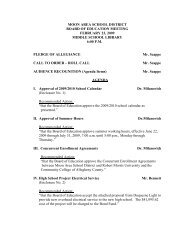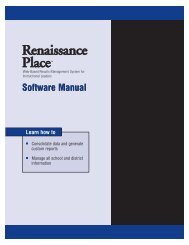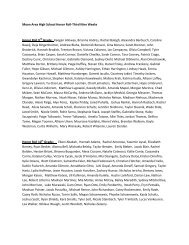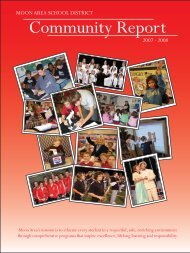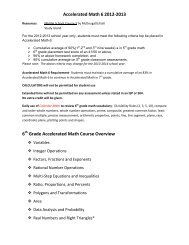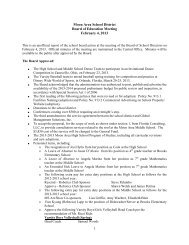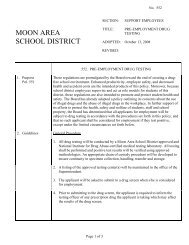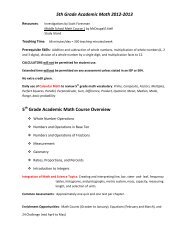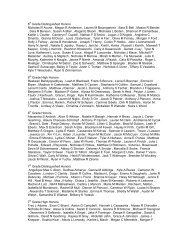2012-2013 Moon Area Middle School Program of Studies
2012-2013 Moon Area Middle School Program of Studies
2012-2013 Moon Area Middle School Program of Studies
Create successful ePaper yourself
Turn your PDF publications into a flip-book with our unique Google optimized e-Paper software.
<strong>Moon</strong> <strong>Area</strong> <strong>School</strong> District<br />
<strong>Moon</strong> <strong>Area</strong> <strong>School</strong> District<br />
904 Beaver Grade Road<br />
<strong>Moon</strong> Township, PA 15108<br />
Phone: 412 264-9440<br />
www.moonarea.net<br />
support students who are scoring below the 40th percentile on groupadministered<br />
standardized tests and need to acquire knowledge <strong>of</strong> Academic<br />
Language, the structure and function <strong>of</strong> the English language.<br />
The Language! Intervention <strong>Program</strong> delivers the six key literacy strands<br />
through a comprehensive, integrated scope and sequence. Every lesson<br />
builds mastery systematically and cumulatively. The ongoing assessment<br />
ensures mastery. It is designed for intermediate students to succeed<br />
in classroom instruction at their grade level. Every lesson integrates<br />
the six literacy strands to teach the English language: phonemic awareness,<br />
word recognition and spelling, vocabulary and morphology, grammar<br />
and usage, listening and reading comprehension, and speaking and<br />
writing.<br />
Phonemic awareness helps students learn the building blocks <strong>of</strong> the<br />
English language. Word recognition and spelling teaches students how<br />
to use the sound-spelling correspondences to fluently read and write<br />
words. Vocabulary and morphology develops the meanings <strong>of</strong> words<br />
students can read and spell. Grammar and usage increases students<br />
understanding <strong>of</strong> sentence parts and patterns. Listening and reading<br />
comprehension uses three different levels <strong>of</strong> text, each with an increasing<br />
level <strong>of</strong> difficulty. Communication skills are developed through speaking<br />
and writing.<br />
Challenge <strong>Program</strong><br />
Children with high academic ability are identified using the <strong>Moon</strong> <strong>Area</strong><br />
<strong>School</strong> District Gifted Screening Matrix for the Challenge <strong>Program</strong>.<br />
Emphasis <strong>of</strong> the program focuses on the enhancement <strong>of</strong> communication,<br />
problem-solving, critical thinking, and creative processing skills.<br />
Achievement <strong>of</strong> the goals occurs by involving students individually and<br />
in small/large group activities such as creative writing, computer program<br />
applications, experiments and problem-solving activities.<br />
The Challenge teachers coordinate with other teachers in the building for<br />
the scheduling <strong>of</strong> Challenge classes in grades five through eight. Students<br />
sign up for competitions, plays, workshops or independent seminars<br />
according to their interests and identified strengths. These include<br />
but are not limited to robotics, theater, chess, academic games, and engineering<br />
workshops.<br />
MAMS<br />
Page 35




